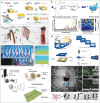Emerging Wearable Acoustic Sensing Technologies
- PMID: 39749384
- PMCID: PMC11809411
- DOI: 10.1002/advs.202408653
Emerging Wearable Acoustic Sensing Technologies
Abstract
Sound signals not only serve as the primary communication medium but also find application in fields such as medical diagnosis and fault detection. With public healthcare resources increasingly under pressure, and challenges faced by disabled individuals on a daily basis, solutions that facilitate low-cost private healthcare hold considerable promise. Acoustic methods have been widely studied because of their lower technical complexity compared to other medical solutions, as well as the high safety threshold of the human body to acoustic energy. Furthermore, with the recent development of artificial intelligence technology applied to speech recognition, speech recognition devices, and systems capable of assisting disabled individuals in interacting with scenes are constantly being updated. This review meticulously summarizes the sensing mechanisms, materials, structural design, and multidisciplinary applications of wearable acoustic devices applied to human health and human-computer interaction. Further, the advantages and disadvantages of the different approaches used in flexible acoustic devices in various fields are examined. Finally, the current challenges and a roadmap for future research are analyzed based on existing research progress to achieve more comprehensive and personalized healthcare.
Keywords: acoustic sensor; human‐machine interface; ultrasonic healthcare; wearable and implantable.
© 2024 The Author(s). Advanced Science published by Wiley‐VCH GmbH.
Conflict of interest statement
The authors declare no conflict of interest.
Figures


















Similar articles
-
Flexible, wearable mechano-acoustic sensors for body sound monitoring applications.Nanoscale. 2025 Apr 17;17(16):9652-9685. doi: 10.1039/d4nr05145a. Nanoscale. 2025. PMID: 40145538 Review.
-
Insights into Materials, Physics, and Applications in Flexible and Wearable Acoustic Sensing Technology.Adv Mater. 2024 Mar;36(9):e2306880. doi: 10.1002/adma.202306880. Epub 2023 Dec 10. Adv Mater. 2024. PMID: 38015990 Review.
-
A High-Fidelity Skin-Attachable Acoustic Sensor for Realizing Auditory Electronic Skin.Adv Mater. 2022 May;34(21):e2109545. doi: 10.1002/adma.202109545. Epub 2022 Apr 12. Adv Mater. 2022. PMID: 35191559
-
Flexible Electronics toward Wearable Sensing.Acc Chem Res. 2019 Mar 19;52(3):523-533. doi: 10.1021/acs.accounts.8b00500. Epub 2019 Feb 15. Acc Chem Res. 2019. PMID: 30767497 Review.
-
Advances in Portable and Wearable Acoustic Sensing Devices for Human Health Monitoring.Sensors (Basel). 2024 Aug 19;24(16):5354. doi: 10.3390/s24165354. Sensors (Basel). 2024. PMID: 39205054 Free PMC article. Review.
Cited by
-
The Influence of DMSO on PVA/PVDF Hydrogel Properties: From Materials to Sensors Applications.Gels. 2025 Feb 13;11(2):133. doi: 10.3390/gels11020133. Gels. 2025. PMID: 39996676 Free PMC article.
-
NIR-Responsive Microbubble Delivery Platforms for Controlled Drug Release in Cancer Therapy.Materials (Basel). 2025 Jun 10;18(12):2725. doi: 10.3390/ma18122725. Materials (Basel). 2025. PMID: 40572858 Free PMC article.
-
Analysis of Personalized Cardiovascular Drug Therapy: From Monitoring Technologies to Data Integration and Future Perspectives.Biosensors (Basel). 2025 Mar 17;15(3):191. doi: 10.3390/bios15030191. Biosensors (Basel). 2025. PMID: 40136988 Free PMC article. Review.
-
Intelligent planetary gear fault diagnosis system based on MEMS acoustic emission sensor.Microsyst Nanoeng. 2025 Jun 18;11(1):126. doi: 10.1038/s41378-025-00961-z. Microsyst Nanoeng. 2025. PMID: 40533473 Free PMC article.
References
Publication types
MeSH terms
Grants and funding
LinkOut - more resources
Full Text Sources
